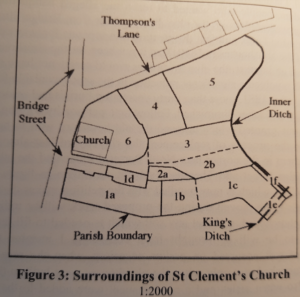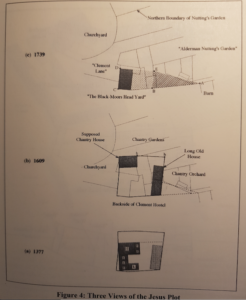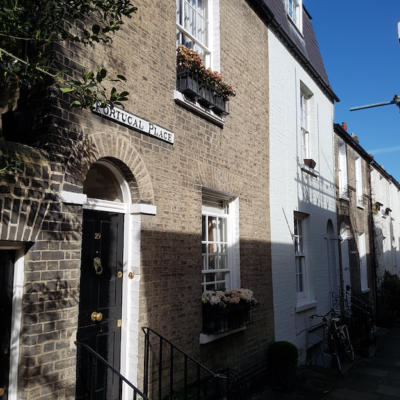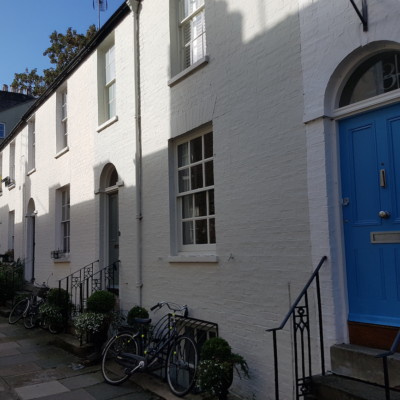Search by topic
- archaeology
- Building of Local Interest
- charity
- church
- crime
- dressmaker
- fire
- Great Eastern Railway
- Listed building
- Mapping Relief
- medieval
- oral history
- poverty
- Public House
- Rattee & Kett
- Religious House
- Roman
- scholar
- school
- Then and Now
- tudor
- women
- work
- world war one
- world war two
Search by text
 9 Portugal Place
9 Portugal Place9 Portugal Place / St Clement’s Chantry / The Cambridge Valet
History of 9 Portugal Place
For more detail see T E Faber, An Intimate History of St Clements, 2006.
The Chantries and the Chantry meadow (area 3)
The chantry dedicated to St Mary was founded before 1279 by Mag. Robert Aunger, with an income of 5 marks derived from properties in the parish left to Robert by his father. In 1311 a certain Alice, widow of Alan Seghyn, passed on her rights to property in an adjacent meadow in favour of Walter de Poswyke vicar of St Clements.
A second chantry was founded in 1323 though the location of this was unclear to Faber p.68. The two chantries clearly struggled in the 14th cent. to find the means to maintain the number of clergy required by them both. In 1472 there was still only one priest for the two chantries even though at least three had been the initial intention at their founding. This priest was Robert Blakamore who had been granted a tenement and garden. In his will of 1503 he is described as perpetual chaplain of the [united] chantry.
Robert’s successor was Thomas Paris.
Next was Robert Massye who died in 1528. He had become quite a wealthy man and ensured a good turn out for his funeral by leaving not only 8d to the vicar for it but also 6d to every other priest attending, 4d to every scholar of Clement Hostel, and 2d to every sizer. He left most of his pewter to young maidens in the parishes of St Clement and the Holy Sepulchre. He also left 16s 8d to St Clement’s church, £3 to his sister and her family, £4 to his servant Thomas Coventre plus his horse and all its fittings. He left to Dr Cliffe all the fittings at the White Bull. From this we can gather that he funded the refitting of the inn and changed the colour of its sign from black to white.
The last chantry priest before the suppression of the Catholic church was Thomas (?) Aldreth. the estates of most if not all of the chantries in and around Cambridge were sold in 1548 to Sir Thomas Wendy and John Barton.
1557 Thomas Ventris pays rent to Jesus college for St Clement’s chantry house. [From this point the ownership of the land tracks that of 8 Portugal Place.]
1609 death of Thomas Ventris
1739 whole area bought by Thomas Nutting by this date
1835 development of eastern end of Portugal Place
1874 S T Fulcher, cabinet maker
1901 Marshalls wine vaults
1907 Dalton and Co bookmakers
1913 ‘The Cambridge Valet’, Ernest Welsh manager
WWI: Pask the tailor until 1937
In WWI seamstresses sat upstairs sewing army chevrons
1933
5 -7a Portugal Place were auctioned. The seller was Samuel Bostock of Sparsholt Manor, Hampshire. 5 & 6 were a pair of cottages, occupants G A Cockerton and Mrs N Caldecoat. They paid £28 13s 4d per annum rent. The properties were sold to publisher Gordon Fraser and in 1935-6 he demolished 5,6 & 7, and by 1939 established a bookshop. Fraser moved into 9 Clement Place in 1939, no. 10 having been demolished in 1937.
In 1981 Paul Carter was quoted in the CWN 7 May: Gordon Fraser’s bookshop was a white elephant because war broke out. During the war the bookshop became a NAAFI. Mr Richard Attenborough used to go down there every morning to have his morning coffee with the other OTC cadets. They would all stand outside singing ‘Why are we waiting?’
1937
jack Carter moved in.
1962 Jack Carter, dress wear hire service
Contribute
Do you have any information about the people or places in this article? If so, then please let us know using the Contact page or by emailing capturingcambridge@
License
This work is licensed under CC BY-NC-SA 4.0










